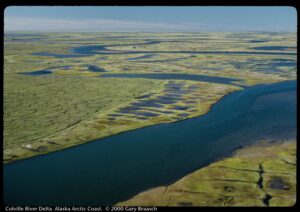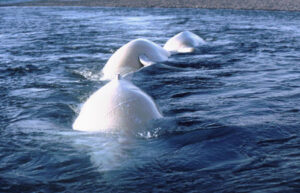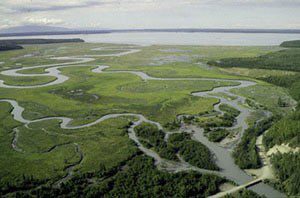IMPORTANT CASES IN 2016
in America's Arctic, Clean Air and Water, Climate Change, Marine Ecosystems, News, Wild Lands & Wildlife
Trustees for Alaska’s work in 2016 will continue to defend what we love about Alaska, as we have done for over 40 years. Our work is currently concentrated on these conservation issues and legal cases:
- Providing general legal counsel in proactive campaigns to protect lands in the Arctic, keep coal in the ground to slow climate change, and defend Bristol Bay;
- Continuing our current active cases to keep water in streams for fish, protect communities from the harmful impacts of coal mining and export, and safeguard Wilderness;
- Analyzing legislative and other changes to environmental laws, and challenging them when necessary;
- Evaluating resource extraction and industrial infrastructure projects to make sure important renewable resources are protected, and strong citizen involvement is included; and
- Working to address broader environmental policy questions relating to climate change and citizen participation in resource decision making.
AMERICA’S ARCTIC
Trustees for Alaska has a long history of protecting Arctic ecosystems, beginning with our founding to address the impacts of the 800-mile Trans-Alaska Pipeline System, which moves oil from the Arctic to the port of Valdez. Alaska has the only Arctic environment in the United States and is suffering impacts from climate change at a greater rate than the rest of the nation.
The goal of Trustees for Alaska for our Arctic program is to stop infrastructure, mining, and oil development in the Arctic that would permanently damage sensitive Arctic ecosystems. We work to achieve protection of sensitive areas from resource development.
Arctic National Wildlife Refuge
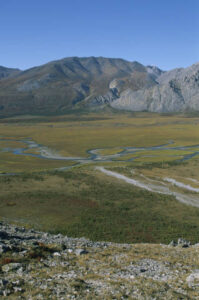
The Arctic National Wildlife Refuge is an important area for the the Porcupine Caribou Herd. USFWS photo
The Coastal Plain of the Arctic National Wildlife Refuge is the iconic battleground between oil exploitation and wilderness preservation. The Arctic Refuge provides exceptional habitat for numerous birds and mammals, including polar bears, wolves, muskox, the Porcupine Caribou Herd, and over 200 bird species that migrate from the Coastal Plain to six continents. Trustees for Alaska provides legal support to the Arctic Refuge coalition groups’ efforts to permanently protect the Coastal Plain of the Arctic Refuge.
In early 2015, President Obama and U.S. Fish & Wildlife Service recommended that Congress designate 12.28 million acres of the Arctic Refuge as Wilderness, including the vitally important Coastal Plain. Despite this recommendation, our Senators continue to introduce bills that would open the Coastal Plain to drilling. Until there is permanent protection for the Arctic Refuge, Trustees for Alaska will provide legal support to defeat drilling proposals and support bills that would permanently protect the Coastal Plain as Wilderness. Trustees also stands ready to defend the Arctic Refuge from any legal challenges that might undercut protections for the Refuge.
Offshore Oil and Gas Development
The State has vast areas that it opens for oil and gas leasing. Trustees has worked for many years to ensure that the public is involved in those decisions and to ensure that the State properly evaluates the impacts. In 2013, Trustees won a challenge to the Department of Natural Resources’ (DNR) Best Interest Finding for the Beaufort Sea Areawide Lease Sale. The decision requires DNR to consider the cumulative impacts of exploration and development as the phases of oil and gas development proceed and to involve the public in its review. The State has started approving exploration permits that do not include the analysis required by the decision, and we are reviewing, commenting, and evaluating administrative challenges and litigation to enforce that ruling. We also have two pending administrative appeals of approvals that were issued without the required analysis. While the focus of this work is in the Arctic region, the results can have statewide impact and we continue to look for ways to broaden the scope of the victory.
National Petroleum Reserve-Alaska (Reserve)
The Reserve provides rich habitat for caribou, grizzly and polar bears, wolves, a wide range of migratory birds, and multiple caribou herds, including the Western Arctic Caribou Herd. The Reserve also contains numerous special areas, including the most well-known, Teshekpuk Lake. Despite its unique habitat, fish, and wildlife values and the importance of the Reserve to subsistence users in the region, large areas of the Reserve are open to oil and gas development.
Trustees recently represented five individuals from Nuiqsut—the community closest to oil and gas development in the Reserve—who depend on the lands surrounding their village for subsistence hunting and fishing. Existing oil development near their community is already threatening their subsistence way of life. ConocoPhillips is now moving forward with additional development in the Reserve at the Greater Mooses Tooth 1 and 2 pads (GMT-1 & GMT-2). When allowing GMT-1 to go forward, BLM recognized there would be significant impacts to subsistence. To address some of those impacts, BLM is currently undertaking a process to develop a Regional Mitigation Strategy (RMS) that will inform not only how it mitigates the impacts from GMT-1, but will serve as a blueprint for how BLM will mitigate against development impacts in the future. We are advising clients on legal issues related to the RMS to ensure that BLM protects the important fish, wildlife, and habitat values of the Reserve.
Ambler Road and Mining
The State of Alaska is moving forward with plans to build a 211-mile long industrial access road across the Southern Brooks Range from the Dalton Highway through Gates of the Arctic National Park & Preserve. The Southern Brooks Range is home to some of Alaska’s most spectacular wild places and provides exceptional habitat for three different caribou herds, grizzly bears, wolves, Dall sheep, moose, and wolverines. Despite the State’s current fiscal crisis, the Governor recently allowed the Alaska Industrial Development and Export Authority to apply for the right-of-way and other permits necessary to build the road. The road would be for the exclusive benefit of special interests like a Canadian mining company, and would be built at the expense of Alaskans living in the region. Trustees for Alaska is working with a coalition of tribes, organizations, and individuals opposed to this enormous corporate subsidy.
CLIMATE CHANGE
Climate change is happening twice as fast in Alaska than the rest of the nation. Retreat of sea ice, loss of permafrost and melting glaciers are impacting communities and wildlife. Villages are eroding into the ocean, walrus are hauling out on shore, and polar bears may very well become extinct before the end of this century.
Trustees for Alaska is working to keep Alaska’s vast coal fields in the ground, both to protect salmon habitat and to avoid further contribution to the world’s greenhouse gas emission problem.
Stopping the Chuitna Coal Strip Mine
PacRim Coal proposes to develop a coal strip mine near the Chuitna River on the west side of Cook Inlet. The project would include strip mining about 5,000 acres over 25 years and extracting approximately 300 million metric tons of coal. The development plan envisions mining through more than 25 miles of salmon-bearing streams, and the destruction of thousands of acres of wetlands. Stopping the proposed Chuitna Coal Strip Mine is currently the biggest battle in the fight to keep Alaska’s coal in the ground.
In 2015, Trustees for Alaska secured the first ever private water reservation for the Chuitna Citizens Coalition; we are now defending it against challenges from the State, PacRim Coal, and other industry and corporate interests. We are also working to ensure our clients’ voices are heard in the upcoming permitting processes by State and Federal Agencies. We anticipate public review of the proposed mine’s Draft Supplemental Environmental Impact Statement in 2016.
Matanuska Coalfields
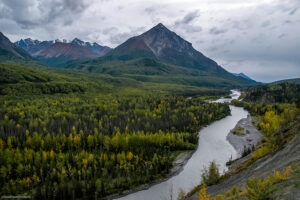
Parts of the Matanuska Valley are at risk of becoming coal strip mines. Trustees for Alaska is working to ensure local citizen’s have a say in that. Photo (c) Daniel Hoherd / Flickr
The Matanuska Valley is an historical coal mining area that has since given way to residential development and strong communities. Three companies have attempted to re-establish coal mining in the Mat Valley in recent years: (1) Usibelli Coal Mining Co., the only active coal mining company in Alaska, is trying to move forward on the Wishbone Hill coal leases; (2) Ranger Alaska, a subsidiary of Black Range Minerals, has a permit for the Jonesville Coal Mine; and (3) Riversdale has purchased leases in Chickaloon.
After significant local opposition, the Wishbone Hill project is the only project that is currently active. Trustees for Alaska works with the Mat Valley Coalition to monitor and oppose activities that would revive coal mining under long-expired permits. In the next year, we will continue working to nullify the decades-old permits and require the State to apply current permitting requirements to attempts to revive mining on Wishbone Hill coal leases.
Office of Surface Mining Advocacy
The Federal Office of Surface Mining (OSM) oversees Alaska’s Coal Program, and must ensure that it is consistent with federal law. Trustees for Alaska petitioned OSM to correct a significant problem with the Alaska program. Its provisions on attorneys’ fees conflict with federal requirements. OSM agreed and is now requiring the State to undertake statutory changes to bring the Alaska Program into compliance. We will track the State’s progress and engage in public and agency processes to ensure that the changes meet the requirements of the federal law.
Monitoring Increasing Vessel Traffic in the Arctic
With climate change causing longer ice-free periods in the Arctic, shipping traffic is increasing in the Bering Sea and Arctic Ocean. Increased shipping traffic requires more ports and spill response facilities. These ports will also facilitate transportation infrastructure in areas currently inaccessible for natural resource development. Over the next year, Trustees for Alaska will monitor the various potential port projects as well as the actions of the Arctic Council.
Working with the Campaign on Climate Change
We work with a coalition of organizations that are seeking solutions to address climate change in Alaska. In 2007, Trustees for Alaska petitioned the Alaska Department of Environmental Conservation (DEC) for regulations that would require facilities to quantify and report emissions and fuel use. DEC denied our petition and has not made any progress on greenhouse gas emissions reporting since publishing its emissions inventory in February of 2008. Trustees will continue to seek statutory and regulatory measures that can reduce the impacts of climate change in Alaska.
MARINE ECOSYSTEMS
More than half the United States’ coastline is found in Alaska, and Alaska’s fisheries are among the most productive in the world. Trustees for Alaska participates in and provides legal advice to coalitions working on marine ecosystems issues as well as legal advocacy on projects directly impacting the marine environment. Trustees works to defend Alaska’s rich marine waters from threats by development projects including oil and gas, transportation and other activities that degrade the environmental health of marine ecosystems.
Cook Inlet Beluga Whale
The ten-year effort spearheaded by Trustees for Alaska culminated with the listing of the Cook Inlet beluga whale as an endangered species in 2008. The State of Alaska challenged the listing in court, and Trustees for Alaska represented various groups as intervenors. We prevailed in the case and the listing stands. We continue to monitor the plight of these small white whales and to participate in the designation of their critical habitat and development of a recovery plan. We are also taking a close look at projects in Cook Inlet to assess cumulative impacts of these projects on the beluga’s survival and recovery. Additionally, we have overlapping work that also could lead to additional protections for beluga whales, including our challenge to discharge exemptions given to Cook Inlet oil and gas operators, opposing the Knik Arm Bridge, ending the secondary treatment waiver given to the Point Woronzof Waste Water Treatment Facility, and our fight to keep Chuitna Coal in the ground and water in the tributaries of the Chuitna River. All of these impact beluga critical habitat in Cook Inlet.
WILDLANDS & WILDLIFE
Alaska holds vast spectacular public lands and waters, including over half of the nation’s designated Wilderness Areas, National Wildlife Refuges, and National Parks. The public lands and waters of Alaska are essential to Alaska’s culture and economy, the backbone of the nation’s conservation reserve system, and an example to the world for conserving wild natural landscapes. Alaska’s wildlife are also iconic and a vital part of Alaska’s natural history and way of life. However, many of Alaska’s wildlife populations are besieged by habitat loss, resource exploitation, climate change, and a poor wildlife management regime.
Trustees works to: (1) develop environmentally protective case law interpreting the Alaska National Interest Lands Conservation Act (ANILCA) and other public lands laws to protect Alaska’s public lands over the long-term; (2) ensure that land management planning addresses the long-term protection of lands and balances the various uses of public lands; (3) ensure that projects undertaken on public lands comply with environmental laws; (4) maintain Alaska’s biodiversity by protecting habitat and using state and federal endangered species laws to prevent the extinction or extirpation of species; and (5) ensure that wildlife management laws are properly executed and that management decisions are based upon scientific wildlife management principles. Our work in this program area involves ongoing analysis and advocating consistency in the application of ANILCA in all program areas, ensuring that federal resource management plans protect public resources, ensuring that important public lands are not given away in land exchanges, and ensuring that predator control laws are supported by science.
Protecting Izembek Wilderness and Waterfowl Habitat
In 2015, we helped to protect Izembek National Wildlife Refuge from a land swap and an unneeded, expensive, and dangerous road proposed through internationally important waterfowl habitat and designated Wilderness. Trustees for Alaska, on behalf of eight conservation groups, intervened in a federal lawsuit that threatened to overturn the decision made by the Secretary of the Interior to reject the proposed incursion into Wilderness. The decision has been appealed, so the fight to protect Wilderness continues. We also support the legislative efforts of the groups, as needed, to respond to efforts in Congress to mandate the land exchange and road.
Predator Control Programs for Wolves and Bears
Building on our recent success in supporting stricter sport hunting limits on national preserve lands, Trustees for Alaska will continue to provide legal advice to conservation groups participating in the recently published US Fish and Wildlife Service’s regulations to protect predators on Alaska’s national wildlife refuges from the State of Alaska’s increasingly aggressive predator control programs.
Navigable Waters
John Sturgeon, who was illegally using a hovercraft within Yukon-Charley Rivers National Preserve, sued the National Park Service, challenging its authority to regulate boating inside the preserve. He lost at the federal district court and at the U.S. Court of Appeals. Trustees for Alaska represented the National Parks Conservation Association as amicus curiae, or friend of the court. This case is now before the US Supreme Court. Trustees provided a brief to the court on behalf of thirteen organizations in this important case. While the original case was local to Alaska, a Supreme Court decision could have national impacts. A decision from the Court is expected in the spring.
BLM Resource Management Plans
We will continue to provide legal support to various conservation and Native groups regarding the Resource Management Plans (RMPs) being revised by BLM in Alaska. We work with a coalition of groups to ensure preservation of important lands and sound management in these areas. We continue to work to preserve the Alaska Native Claims Settlement Act § 17(d)(1) land withdrawals, which protect millions of acres of land from mineral exploitation (i.e., oil and gas development and hardrock mining).
CLEAN AIR & WATER
Natural resource development, and especially mining, has permanently scarred vast areas of the United States and caused long-term and permanent degradation of water quality. Alaska still has vast areas of pristine, and nearly pristine, land and waters, and it is vital to protect these intact ecosystems that support sustainable economies and the subsistence way of life.
Trustees for Alaska’s goals in this program are to: (1) scrutinize major natural resource exploration and development activities in Alaska to ensure that they comply with existing environmental laws and protect existing resources; (2) develop new statutes, regulations, and case law that increase the protection and standards governing resource exploration and development activities; and (3) ensure that existing exploration and development meets environmental standards and requirements.
Keeping Bristol Bay Pristine
The fight to stop the Pebble Mine is not over. Pebble Limited Partnership has several active federal lawsuits against the Environmental Protection Agency. Trustees is monitoring these cases closely. In addition, we are defending our conservation clients against intrusions into their constitutional right of free speech, which protects their ability to speak against the Pebble Mine.
We are also working with our clients to ensure that state agencies require Pebble to clean up its mess from the past 25 years of exploration activities, including over a thousand drill sites. The lawsuit Trustees brought against DNR in 2009 to require public notice for these exploration activities revealed that many drilling activities left behind sumps and drill cuttings with the potential to harm fish, wildlife, and water resources throughout the Pebble deposit area.
Trustees will continue working to keep Bristol Bay’s world class salmon fishery safe from the hazards of large-scale mining.
Cook Inlet Oil and Gas
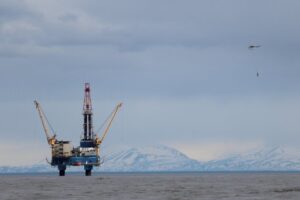
The Osprey oil and gas platform—one of the only facilities that doesn’t discharge directly into Cook Inlet—sits near West Foreland across Cook Inlet from Nikiski. Photo courtesy of Ground Truth Trekking.
Cook Inlet oil and gas activities, once considered on the decline by regulators, have experienced reinvigorated activity as smaller operators have bought up production sites and leases. Potential impacts to the endangered Cook Inlet beluga whale, the lack of best available technology for blowout preventers (demonstrated by the Gulf of Mexico Deepwater Horizon blowout), and lax enforcement in Cook Inlet, are just three of the reasons Trustees for Alaska continues to monitor these operations. The State is expected to reissue a Clean Water Act permit that allows oil and gas facilities to dump millions of gallons of waste directly into Cook Inlet each year. Cook Inlet remains the only coastal waterbody in the United States where oil and gas companies are allowed to dump these wastes directly into a waterbody. Trustees is working with a coalition of organizations, tribes, and other entities to close this pollution loophole and protect the fish and wildlife of Cook Inlet.
Challenging Alaska’s Antidegradation Implementation Methods
Under the Clean Water Act, states are required to have an antidegradation policy, which protects existing uses of all of Alaska’s waterbodies. It also ensures that higher quality waters must be protected to ensure propagation of fish, shellfish, and wildlife and recreation in and on the water are maintained in that state. DEC adopted its antidegradation policy in 1997, but has never promulgated required implementation procedures to make it effective. In 2010, the Alaska Department of Environmental Conservation (DEC) issued Interim Antidegradation Implementation Methods as a guidance document without any public process. After our unsuccessful challenge to the Interim Methods, we achieved a settlement that required DEC to issue the proposed final implementation methods by the end of 2013. We commented on the proposal but instead of finalizing it, DEC has been very slow to issue a new proposal. We will review the new proposal and participate in the public comment period, as well as review the final methods and both DEC and EPA’s decisions when they are issued.
Eagle River Flats Bombing
More than a decade ago, we settled a case on behalf of a coalition of groups concerned about military training exercises at Fort Richardson (now JBER) and its impact on water quality and wildlife on Eagle River Flats. The groups included Alaska Community Action on Toxics, Cook Inletkeeper, and the Chickaloon Tribal Council. We settled the case with a consent decree that, among other things, required the Army to comply with winter-only firing restrictions put in place in 1991 and required the Army to submit an application for a Clean Water Act permit. This past April, immediately after the consent decree expired, the Army resumed firing and bombing activities at the height of the spring bird migration. Trustees worked with our clients to ensure that the Army stopped their unlawful summer firing. The Army wants to resume firing year-round and they are currently in the process of conducting the required environmental analysis. We will continue to work with a coalition of groups to oppose year-round firing and to protect water quality at Eagle River Flats.
LEGISLATURE & STATE GOVERNANCE
We support the work of the conservation groups and tribes working in the legislature with bill analyses, factsheets, and advice during coalition meetings, including legislative drafting work. During the legislative session we provide ongoing counsel to tribal and conservation groups.



